In Vitro Antioxidant, Antimicrobial, Anticoccidial, and Anti-Inflammatory Study of Essential Oils of Oregano, Thyme, and Sage from Epirus, Greece
Abstract
:Simple Summary
Abstract
1. Introduction
2. Materials and Methods
2.1. Plant Sources and Essential Oil Extraction
2.2. Determination of EOs’ Active Compounds
2.3. Determination of Total Phenolic Content of EOs
2.4. Antioxidant Assays
2.4.1. Interaction with DPPH
2.4.2. ABTS Radical Cation Decolorization Assay
2.4.3. Ferric-Reducing Antioxidant Power (FRAP) Assay
2.5. Anti-Inflammatory Assay: Soybean Lipoxygenase Inhibition
2.6. Antimicrobial Capacity
2.6.1. Antibacterial Activity with Disk Diffusion Method
2.6.2. Determination of MIC
2.6.3. Determination of MBC
2.7. Antiparasitic Capacity of EOs
2.7.1. Essential Oils
2.7.2. Cell Culture
2.7.3. Parasites
2.7.4. Cytotoxicity Test
2.7.5. Pretreatment and Infection
2.7.6. Isolation of Nucleic Acids and Real Time Quantitative PCR
2.8. Statistical Analysis
3. Results
3.1. Yield of Crude Extracts and Fractions
3.2. Chemical Composition of Tested EOs
3.3. Total Phenolic Content (TPC) of EOs
3.4. Antioxidant Activity of EOs
3.4.1. Interaction with DPPH and ABTS
3.4.2. FRAP Assay
3.5. Anti-Inflammatory (LOX-Inhibitory) Activity of EOs
3.6. Antibacterial Capacity
3.6.1. Disk Diffusion Assay
3.6.2. Broth Microdilution Method
3.7. Antiparasitic Capacity
Anticoccidial Effect of EOs in Eimeria Tenella Using an In Vitro System
4. Discussion
5. Conclusions
Supplementary Materials
Author Contributions
Funding
Institutional Review Board Statement
Informed Consent Statement
Data Availability Statement
Acknowledgments
Conflicts of Interest
References
- Kosakowska, O.; Węglarz, Z.; Pióro-Jabrucka, E.; Przybył, J.L.; Kraśniewska, K.; Gniewosz, M.; Bączek, K. Antioxidant and Antibacterial Activity of Essential Oils and Hydroethanolic Extracts of Greek Oregano (O. vulgare L. subsp. hirtum (Link) Ietswaart) and Common Oregano (O. vulgare L. subsp. vulgare). Molecules 2021, 26, 988. [Google Scholar] [CrossRef] [PubMed]
- Grigoriadou, K.; Trikka, F.A.; Tsoktouridis, G.; Krigas, N.; Sarropoulou, V.; Papanastasi, K.; Maloupa, E.; Makris, A.M. Μicropropagation and cultivation of Salvia sclarea for essential oil and sclareol production in northern Greece. In Vitro Cell. Dev. Biol. Plant 2020, 56, 51–59. [Google Scholar] [CrossRef]
- Socaci, S.A.; Fărcaş, A.C.; Tofană, M. Functional ingredients derived from aromatic plants. In Feed Additives; Florou-Paneri, P., Christaki, E., Giannenas, I., Eds.; Academic Press: Cambridge, MA, USA, 2020; pp. 133–146. [Google Scholar]
- Zhai, H.; Liu, H.; Wang, S.; Wu, J.; Kluenter, A.M. Potential of essential oils for poultry and pigs. Anim. Nutr. 2018, 4, 179–186. [Google Scholar] [CrossRef] [PubMed]
- Giannenas, I.; Bonos, E.; Filliousis, G.; Stylianaki, I.; Kumar, P.; Lazari, D.; Christaki, E.; Florou-Paneri, P. Effect of a Polyherbal or an Arsenic-Containing Feed Additive on Growth Performance of Broiler Chickens, Intestinal Microbiota, Intestinal Morphology, and Lipid Oxidation of Breast and Thigh Meat. J. Appl. Poult. Res. 2019, 28, 164–175. [Google Scholar] [CrossRef]
- Petrovska, B.B. Historical review of medicinal plants’ usage. Phcog. Rev. 2012, 6, 1–5. [Google Scholar] [CrossRef] [Green Version]
- Jin, S.; Zong, Y.; Gao, Q.; Zhu, Z.; Wang, Y.; Qin, P.; Liang, C.; Wang, D.; Qiu, J.-L.; Zhang, F.; et al. Cytosine, but not adenine, base editors induce genome-wide off-target mutations in rice. Science 2019, 364, 292–295. [Google Scholar] [CrossRef]
- Giannenas, I.; Bonos, E.; Skoufos, I.; Tzora, A.; Stylianaki, I.; Lazari, D.; Tsinas, A.; Christaki, E.; Florou-Paneri, P. Effect of herbal feed additives on performance parameters, intestinal microbiota, intestinal morphology and meat lipid oxidation of broiler chickens. Br. Poult. Sci. 2018, 59, 545–553. [Google Scholar] [CrossRef] [PubMed]
- Rodriguez-Garcia, I.; Silva-Espinoza, B.A.; Ortega-Ramirez, L.A.; Leyva, J.M.; Siddiqui, M.W.; Cruz-Valenzuela, M.R.; Gonzalez-Aguilar, G.A.; Ayala-Zavala, J.F. Oregano Essential Oil as an Antimicrobial and Antioxidant Additive in Food Products. Crit. Rev. Food Sci. Nutr. 2016, 56, 1717–1727. [Google Scholar] [CrossRef] [PubMed]
- Skoufogianni, E.; Solomou, D.; Alexandra, N.; Danalatos, G. Ecology, Cultivation and Utilization of the Aromatic Greek Oregano (Origanum vulgare L.): A Review. Not. Bot. Horti Agrobot. Cluj Napoca 2019, 47, 545–552. [Google Scholar] [CrossRef] [Green Version]
- Benavides, S.; Villalobos-Carvajal, R.; Reyes, J.E. Physical, mechanical and antibacterial properties of alginate film: Effect of the crosslinking degree and oregano essential oil concentration. J. Food Eng. 2012, 110, 232–239. [Google Scholar] [CrossRef]
- Skoufos, I.; Tzora, A.; Giannenas, I.; Tontis, D.; Bartzanas, T.; Kittas, C.; Panagakis, P. Effects of oregano essential oil and attapulgite on growth performance, intestinal microbiota and morphometry in broilers. S. Afr. J. Anim. Sci. 2016, 46, 77–88. [Google Scholar] [CrossRef] [Green Version]
- Socaci, S.A.; Rugină, D.O.; Diaconeasa, Z.M.; Pop, O.L.; Fărcaș, A.C.; Păucean, A.; Tofană, M.; Pintea, A. Antioxidant compounds recovered from food wastes. In Functional Food-Improve Health Through Adequate Food; Chavarri Hueda, M., Ed.; In Tech: Rijeka, Croatia, 2017. [Google Scholar]
- Ultee, A.; Smid, E.J. Influence of carvacrol on growth and toxin production by Bacillus cereus. Internat. J. Food Microbiol. 2001, 64, 373–378. [Google Scholar] [CrossRef]
- Veldhuizen, E.J.A.; Tjeerdsma-Van Bokhoven, J.L.M.; Zweijtzer, C.; Burt, S.A.; Haagsman, H.P. Structural Requirements for the Antimicrobial Activity of Carvacrol. J. Agric. Food Chem. 2006, 54, 1874–1879. [Google Scholar] [CrossRef]
- Gavaric, N.; Mozina, S.S.; Kladar, N.; Bozin, B. Chemical Profile, Antioxidant and Antibacterial activity of Thyme and Oregano Essential Oils, Thymol and Carvacrol and Their Possible Synergism. J. Essent. Oil-Bear. Plants 2015, 18, 1013–1021. [Google Scholar] [CrossRef]
- Hashemipour, H.; Kermanshahi, H.; Golian, A.; Veldkamp, T. Effect of thymol and carvacrol feed supplementation on performance, antioxidant enzyme activities, fatty acid composition, digestive enzyme activities, and immune response in broiler chickens. Poult. Sci. 2013, 92, 2059–2069. [Google Scholar] [CrossRef]
- Alagawany, M.; Farag, M.R.; Abdelnour, S.A.; Elnesr, S.S. A review on the beneficial effect of thymol on health and production of fish. Rev. Aquacult. 2021, 13, 632–641. [Google Scholar] [CrossRef]
- Avila-Ramos, F.; Pro-Martínez, A.; Sosa-Montes, E.; Cuca-García, J.M.; Becerril-Pérez, C.M.; Figueroa-Velasco, J.L.; Narciso-Gaytán, C. Effects of dietary oregano essential oil and vitamin E on the lipid oxidation stability of cooked chicken breast meat. Poult. Sci. 2012, 91, 505–511. [Google Scholar] [CrossRef] [PubMed]
- Bozin, B.; Mimica-Dukic, N.; Samojlik, I.; Jovin, E. Antimicrobial and Antioxidant Properties of Rosemary and Sage (Rosmarinus officinalis L. and Salvia officinalis L., Lamiaceae) Essential Oils. J. Agric. Food Chem. 2007, 55, 7879–7885. [Google Scholar] [CrossRef]
- Selmi, S.; Sadok, S. The effect of natural antioxidant (Thymus vulgaris Linnaeus) on flesh quality of tuna (Thunnus thynnus (Linnaeus)) during chilled storage. Pan-Am. J. Aquat. Sci. 2008, 3, 36–45. [Google Scholar]
- Gumus, C.E.; Decker, E.A.; McClements, D.J. Impact of legume protein type and location on lipid oxidation in fish oil-in-water emulsions: Lentil, pea, and faba bean proteins. Food Res. Int. 2017, 100, 175–185. [Google Scholar] [CrossRef]
- Ribeiro-Santos, R.; Andrade, M.; Sanches-Silva, A.; Ramos de Melo, N. Essential Oils for Food Application: Natural Substances with Established Biological Activities. Food Bioprocess Technol. 2018, 11, 43–71. [Google Scholar] [CrossRef]
- Avola, R.; Granata, G.; Geraci, C.; Napoli, E.; Graziano, A.C.E.; Cardile, V. Oregano (Origanum vulgare L.) essential oil provides anti-inflammatory activity and facilitates wound healing in a human keratinocytes cell model. Food Chem. Toxicol. 2020, 144, 111586. [Google Scholar] [CrossRef] [PubMed]
- Gaur, S.; Kuhlenschmidt, T.B.; Kuhlenschmidt, M.; Juan, S.; Andrade, E. Effect of oregano essential oil and carvacrol on Cryptosporidium parvum infectivity in HCT-8 cells. Parasitol. Int. 2018, 67, 170–175. [Google Scholar] [CrossRef]
- Tasdemir, D.; Kaiser, M.; Demirci, B.; Demirci, F.; Baser, K.H.C. Antiprotozoal Activity of Turkish Origanum onites Essential Oil and Its Components. Molecules 2019, 24, 4421. [Google Scholar] [CrossRef] [PubMed] [Green Version]
- Burt, S.A.; Tersteeg-Zijderveld, M.H.G.; Jongerius-Gortemaker, B.G.M.; Vervelde, L.; Vernooij, J.C. In vitro inhibition of Eimeria tenella invasion of epithelial cells by phytochemicals. Vet. Parasitol. 2013, 191, 374–378. [Google Scholar] [CrossRef] [Green Version]
- Giannenas, I.; Florou-Paneri, P.; Papazahariadou, M.; Christaki, E.; Botsoglou, N.A.; Spais, A.B. Effect of dietary supplementation with oregano essential oil on performance of broilers after experimental infection with Eimeria tenella. Arch. Anim. Nutr. 2003, 57, 99–106. [Google Scholar] [CrossRef]
- Aljabeili, H.S.; Barakat, H.; Abdel-Rahman, H.A. Chemical Composition, Antibacterial and Antioxidant Activities of Thyme Essential Oil (Thymus vulgaris). Food Nutr. Sci. 2018, 9, 433–446. [Google Scholar] [CrossRef] [Green Version]
- Sidiropoulou, E.; Skoufos, I.; Marugán-Hernández, V.; Giannenas, I.; Bonos, E.; Aguiar-Martins, K.; Lazari, D.; Blake, D.P.; Tzora, A. In vitro Anticoccidial Study of Oregano and Garlic Essential Oils and Effects on Growth Performance, Fecal Oocyst Output, and Intestinal Microbiota in vivo. Front. Vet. Sci. 2020, 7, 420. [Google Scholar] [CrossRef]
- Borugă, O.; Jianu, C.; Mişcă, C.; Goleţ, I.; Gruia, A.T.; Horhat, F.G. Thymus vulgaris essential oil: Chemical composition and antimicrobial activity. J. Med. Life 2014, 7, 56–60. [Google Scholar]
- Rota, M.C.; Herrera, A.; Martínez, R.M.; Sotomayor, J.A.; Jordán, M.J. Antimicrobial activity and chemical composition of Thymus vulgaris, Thymus zygis and Thymus hyemalis essential oils. Food Control 2008, 19, 681–687. [Google Scholar] [CrossRef]
- Ezzat Abd El-Hack, M.; Alagawany, M.; Ragab Farag, M.; Tiwari, R.; Karthik, K.; Dhama, K.; Zorriehzahra, J.; Adel, M. Beneficial impacts of thymol essential oil on health and production of animals, fish and poultry: A review. J. Essent. Oil Res. 2016, 28, 365–382. [Google Scholar] [CrossRef]
- Ghabraie, M.; Dang, V.K.; Tata, L.; Salmieri, S.; Lacroix, M. Antimicrobial effect of essential oils in combinations against five bacteria and their effect on sensorial quality of ground meat. LWT 2016, 66, 332–339. [Google Scholar] [CrossRef]
- Severino, R.; Vu, K.D.; Donsì, F.; Salmieri, S.; Ferrari, G.; Lacroix, M. Antibacterial and physical effects of modified chitosan based-coating containing nanoemulsion of mandarin essential oil and three non-thermal treatments against Listeria innocua in green beans. Int. J. Food Microbiol. 2014, 191, 82–88. [Google Scholar] [CrossRef] [PubMed]
- Mikus, J.; Steverding, D. A simple colorimetric method to screen drug cytotoxicity against Leishmania using the dye Alamar Blue®. Parasitol. Int. 2000, 48, 265–269. [Google Scholar] [CrossRef]
- Ghorbani, A.; Esmaeilizadeh, M. Pharmacological properties of Salvia officinalis and its components. J. Tradit. Complement. Med. 2017, 7, 433–440. [Google Scholar] [CrossRef] [PubMed]
- Risaliti, L.; Kehagia, A.; Daoultzi, E.; Lazari, D.; Bergonzi, M.C.; Vergkizi-Nikolakaki, S.; Hadjipavlou-Litina, D.; Bilia, A.R. Liposomes loaded with Salvia triloba and Rosmarinus officinalis essential oils: In vitro assessment of antioxidant, antiinflammatory and anti-bacterial activities. J. Drug Deliv. Sci. Technol. 2019, 51, 493–498. [Google Scholar] [CrossRef]
- Poulios, E.; Giaginis, C.; Vasios, G.K. Current advances on the extraction and identification of bioactive components of sage (Salvia spp.). Curr. Pharm. Biotechnol. 2019, 20, 845–857. [Google Scholar] [CrossRef]
- Poulios, E.; Giaginis, C.; Vasios, G.K. Current State of the Art on the Antioxidant Activity of Sage (Salvia spp.) and Its Bioactive Components. Planta Med. 2020, 86, 224–238. [Google Scholar] [CrossRef] [Green Version]
- Cutillas, A.B.; Carrasco, A.; Martinez-Gutierrez, R.; Tomas, V.; Tudela, J. Salvia officinalis L. Essential Oils from Spain: Determination of Composition, Antioxidant Capacity, Anti-enzymatic, and Antimicrobial Bioactivities. Chem. Biodivers. 2017, 14, e1700102. [Google Scholar] [CrossRef]
- Mohammed, H.A.; Eldeeb, H.M.; Khan, R.A.; Al-Omar, M.S.; Mohammed, S.A.A.; Sajid, M.S.M.; Aly, M.S.A.; Ahmad, A.M.; Abdellatif, A.A.H.; Eid, S.Y.; et al. Sage, Salvia officinalis L., Constituents, Hepatoprotective Activity, and Cytotoxicity Evaluations of the Essential Oils Obtained from Fresh and Differently Timed Dried Herbs: A Comparative Analysis. Molecules 2021, 26, 5757. [Google Scholar] [CrossRef]
- Van Den Dool, H.; Kratz, P.D. A generalization of the retention index system including linear temperature programmed gas-liquid partition chromatography. J. Chromatogr. A 1963, 11, 463–471. [Google Scholar] [CrossRef]
- Adams, R.P. Identification of Essential Oil Components by Gas Chromatography/Mass Spectrometry; Allured Publishing Corporation: Carol Stream, IL, USA, 2007; Volume 456, p. 8. [Google Scholar]
- Massada, Y. Analysis of Essential Oil by Gas Chromatography and Spectrometry; John Willey & Sons: New York, NY, USA, 1976; p. 334. [Google Scholar]
- Kiritsakis, K.; Kontominas, M.G.; Kontogiorgis, C.; Hadjipavlou-Litina, D.; Moustakas, A.; Kiritsakis, A. Composition and Antioxidant Activity of Olive Leaf Extracts from Greek Olive Cultivars. J. Am. Oil Chem. Soc. 2010, 87, 369–376. [Google Scholar] [CrossRef]
- Zhen, J.; Villani, T.S.; Guo, Y.; Qi, Y.; Chin, K.; Pan, M.H.; Ho, C.T.; Simon, J.E.; Wu, Q. Phytochemistry, antioxidant capacity, total phenolic content and anti-inflammatory activity of Hibiscus sabdariffa leaves. Food Chem. 2016, 190, 673–680. [Google Scholar] [CrossRef]
- Benzie, I.F.; Devaki, M. The ferric reducing/antioxidant power (FRAP) assay for non-enzymatic antioxidant capacity: Concepts, procedures, limitations and applications. In Measurement of Antioxidant Activity & Capacity: Recent Trends and Applications; Apak, R., Capanoglu, E., Shahidi, F., Eds.; Wiley: New York, NY, USA, 2017; Volume 11, pp. 77–106. [Google Scholar] [CrossRef]
- Ondua, M.; Njoya, E.M.; Abdalla, M.A.; McGaw, L.J. Anti-inflammatory and antioxidant properties of leaf extracts of eleven South African medicinal plants used traditionally to treat inflammation. J. Ethnopharmacol. 2019, 234, 27–35. [Google Scholar] [CrossRef] [PubMed]
- Pastor-Fernández, I.; Pegg, E.; Macdonald, S.; Tomley, F.M.; Blake, D.P.; Marugán-Hernández, V. Laboratory growth and genetic manipulation of Eimeria tenella. Curr. Prot. Microbiol. 2019, 53, e81. [Google Scholar] [CrossRef] [Green Version]
- Thabet, A.; Alnassan, A.A.; Daugschies, A.; Bangoura, B. Combination of cell culture and qPCR to assess the efficacy of different anticoccidials on Eimeria tenella sporozoites. Parasitol. Res. 2015, 114, 2155–2163. [Google Scholar] [CrossRef] [PubMed]
- Marugán-Hernández, V.; Cockle, C.; Macdonald, S.; Pegg, E.; Crouch, C.; Blake, D.P.; Tomley, F.M. Viral proteins expressed in the protozoan parasite Eimeria tenella are detected by the chicken immune system. Parasit. Vectors 2016, 9, 463. [Google Scholar] [CrossRef] [PubMed] [Green Version]
- Tripathi, K.D. Essentials of Medical Pharmacology, 7th ed.; Jaypee Bros Medical Publishers (Ltd.): New Delhi, India, 2013. [Google Scholar]
- Rusenova, N.; Parvanov, P. Antimicrobial activities of twelve essential oils against microorganism of veterinary importance. Trakia J. Sci. 2009, 7, 37–43. [Google Scholar]
- Hitokoto, H.; Morozumi, S.; Wauke, T.; Sakai, S.; Kurata, H. Inhibitory effects of spices on growth and toxin production of toxigenic fungi. Appl. Envir. Microbiol. 1980, 39, 818–822. [Google Scholar] [CrossRef] [Green Version]
- Martínez-Tomé, M.; Jiménez-Monreal, A.; Ruggieri, S.; Frega, N.; Strabbioli, R.; Murcia, M. Antioxidant Properties of Mediterranean Spices Compared with Common Food Additives. J. Food Prot. 2001, 64, 1412–1419. [Google Scholar] [CrossRef]
- McGaw, L.J.; Jäger, A.K.; van Staden, J. Antibacterial, anthelmintic and anti-amoebic activity in South African medicinal plants. J. Ethnopharmacol. 2000, 72, 247–263. [Google Scholar] [CrossRef]
- Wei, A.; Shibamoto, T. Antioxidant/lipoxygenase inhibitory activities and chemical compositions of selected essential oils. J. Agric. Food Chem. 2010, 58, 7218–7225. [Google Scholar] [CrossRef] [PubMed]
- Abdelli, W.; Bahri, F.; Romane, A.; Höferl, M.; Wanner, J.; Schmidt, E.; Jirovetz, L. Chemical composition and anti-inflammatory activity of Algerian Thymus vulgaris essential oil. Nat. Prod. Com. 2017, 12, 611–614. [Google Scholar] [CrossRef] [Green Version]
- Hotta, M.; Nakata, R.; Katsukawa, M.; Hori, K.; Takahashi, S.; Inoue, H. Carvacrol, a component of thyme oil, activates PPARα and γ and suppresses COX-2 expression. J. Lipid Res. 2010, 51, 132–139. [Google Scholar] [CrossRef] [Green Version]
- Leyva-López, N.; Gutiérrez-Grijalva, E.P.; Vazquez-Olivo, G.; Heredia, J.B. Essential Oils of Oregano: Biological Activity beyond Their Antimicrobial Properties. Molecules 2017, 22, 989. [Google Scholar] [CrossRef] [Green Version]
- Arranz, L.; Sánchez-Aguilera, A.; Martín-Pérez, D.; Isern, J.; Langa, X.; Tzankov, A.; Lundberg, P.; Muntión, S.; Tzeng, Y.S.; Lai, D.M.; et al. Neuropathy of haematopoietic stem cell niche is essential for myeloproliferative neoplasms. Nature 2014, 512, 78–81. [Google Scholar] [CrossRef]
- Han, X.; Parker, T.L. Anti-inflammatory activity of clove (Eugenia caryophyllata) essential oil in human dermal fibroblasts. Pharm. Biol. 2017, 55, 1619–1622. [Google Scholar] [CrossRef] [Green Version]
- Lima, M.D.S.; Quintans-Júnior, L.J.; de Santana, W.A.; Martins Kaneto, C.; Pereira Soares, M.B.; Villarreal, C.F. Anti-inflammatory effects of carvacrol: Evidence for a key role of interleukin-10. Eur. J. Pharmacol. 2013, 699, 112–117. [Google Scholar] [CrossRef] [Green Version]
- Han, X.; Parker, T.L. Anti-inflammatory Activity of Cinnamon (Cinnamomum zeylanicum) Bark Essential Oil in a Human Skin Disease Model. Phytother. Res. 2017, 31, 1034–1038. [Google Scholar] [CrossRef] [Green Version]
- Alberti, T.B.; Barbosa, W.L.R.; Vieira, J.L.F.; Raposo, N.R.B.; Dutra, R. (−)-β-Caryophyllene, a CB2 Receptor-Selective Phytocannabinoid, Suppresses Motor Paralysis and Neuroinflammation in a Murine Model of Multiple Sclerosis. Int. J. Mol. Sci. 2017, 18, 691. [Google Scholar] [CrossRef]
- Berdowska, I.; Zieliński, B.; Fecka, I.; Kulbacka, J.; Saczko, J.; Gamian, A. Cytotoxic impact of phenolics from Lamiaceae species on human breast cancer cells. Food Chem. 2013, 141, 1313–1321. [Google Scholar] [CrossRef] [PubMed]
- Abbas, A.; Benoist, C.; Bluestone, J.; Campbell, D.J.; Ghosh, S.; Hori, S.; Jiang, S.; Kuchroo, V.K.; Mathis, D.; Roncarolo, G.M.; et al. Regulatory T cells: Recommendations to simplify the nomenclature. Nat. Immunol. 2013, 14, 307–308. [Google Scholar] [CrossRef] [PubMed]
- Solomakos, N.; Govaris, A.; Koidis, P.; Botsoglou, N. The antimicrobial effect of thyme essential oil, nisin and their combination against Escherichia coli O157:H7 in minced beef during refrigerated storage. Meat Sci. 2008, 80, 159–166. [Google Scholar] [CrossRef] [PubMed]
- Khalafalla, R.E.; Müller, U.; Shahiduzzaman, M.; Dyachenko, V.; Desouky, A.Y.; Alber, G.; Daugschies, A. Effects of curcumin (diferuloylmethane) on Eimeria tenella sporozoites in vitro. Parasitol. Res. 2011, 108, 879–886. [Google Scholar] [CrossRef] [PubMed]
- Marugán-Hernández, V.; Jeremiah, G.; Aguiar-Martins, K.; Burrell, A.; Vaughan, S.; Xia, D.; Randle, N.; Tomley, F. The growth of Eimeria tenella: Characterization and application of quantitative methods to assess sporozoite invasion and endogenous development in cell culture. Front. Cell. Infect. Microbiol. 2020, 10, 568. [Google Scholar] [CrossRef]
- Jitviriyanon, S.; Phanthong, P.; Lomarat, P.; Bunyapraphatsara, N.; Porntrakulpipat, S.; Paraksa, N. In vitro study of anti-coccidial activity of essential oils from indigenous plants against Eimeria tenella. Vet. Parasitol. 2016, 228, 96–102. [Google Scholar] [CrossRef]
- Sikkema, J.; De Bont, J.A.M.; Poolman, B. Mechanisms of membrane toxicity of hydrocarbons. Microbiol. Rev. 1995, 59, 201–222. [Google Scholar] [CrossRef]
- Nazzaro, F.; Fratianni, F.; De Martino, L.; Coppola, R.; De Feo, V. Effect of Essential Oils on Pathogenic Bacteria. Pharmaceuticals 2013, 6, 1451–1474. [Google Scholar] [CrossRef]
- Al-Harrasi, A.; Bhatia, S.; Behl, T.; Kaushik, D.; Ahmed, M.M.; Anwer, K. Antibacterial Mechanism of Action of Essential Oils. In Role of Essential Oils in the Management of COVID-19; CRC Press: Boca Raton, FL, USA, 2022; pp. 227–237. [Google Scholar]
- Sharifi-Rad, M.; Varoni, E.M.; Iriti, M.; Martorell, M.; Setzer, W.N.; del Mar Contreras, M.; Salehi, B.; Soltani-Nejad, A.; Rajabi, S.; Tajbakhsh, M.; et al. Carvacrol and human health: A comprehensive review. Phytother. Res. 2018, 32, 1675–1687. [Google Scholar] [CrossRef]
- Schimmer, O.; Häfele, F.; Krüger, A. The mutagenic potencies of plant extracts containing quercetin in Salmonella typhimurium TA98 and TA100. Mutat. Res. Genet. Toxicol. 1988, 206, 201–208. [Google Scholar] [CrossRef]
- Schimmer, O.; Krüger, A.; Paulini, H.; Haefele, F. An evaluation of 55 commercial plant extracts in the Ames mutagenicity test. Pharmazie 1994, 49, 448–451. [Google Scholar] [PubMed]
- Higashimoto, M.; Purintrapiban, J.; Kataoka, K.; Kinouchi, T.; Vinitketkumnuen, U.; Akimoto, S.; Matsumoto, H.; Ohnishi, Y. Mutagenicity and antimutagenicity of extracts of three spices and a medicinal plant in Thailand. Mut. Res. Let. 1993, 303, 135–142. [Google Scholar] [CrossRef]
- De Sã Ferrira, I.C.F.; Ferrão Vargas, V.M. Mutagenicity of medicinal plant extracts in Salmonella/microsome assay. Phytother. Res. 1999, 13, 397–400. [Google Scholar] [CrossRef]
- Kassie, F.; Parzefall, W.; Musk, S.; Johnson, I.; Lamprecht, G.; Sontag, G.; Knasmüller, S. Genotoxic effects of crude juices from Brassica vegetables and juices and extracts from phytopharmaceutical preparations and spices of cruciferous plants origin in bacterial and mammalian cells. Chem.-Biol. Interact. 1996, 102, 1–16. [Google Scholar] [CrossRef]
- Hessenberger, S.; Schatzmayer, G.; Teichmann, K. In vitro inhibition of Eimeria tenella sporozoite invasion into host cells by probiotics. Vet. Parasitol. 2016, 229, 93–98. [Google Scholar] [CrossRef]
- Zhang, X.; Guo, Y.; Guo, L.; Jiang, H.; Ji, Q. In Vitro Evaluation of Antioxidant and Antimicrobial Activities of Melaleuca alternifolia Essential Oil. Biomed Res. Int. 2018, 2018, 2396109. [Google Scholar] [CrossRef] [PubMed]
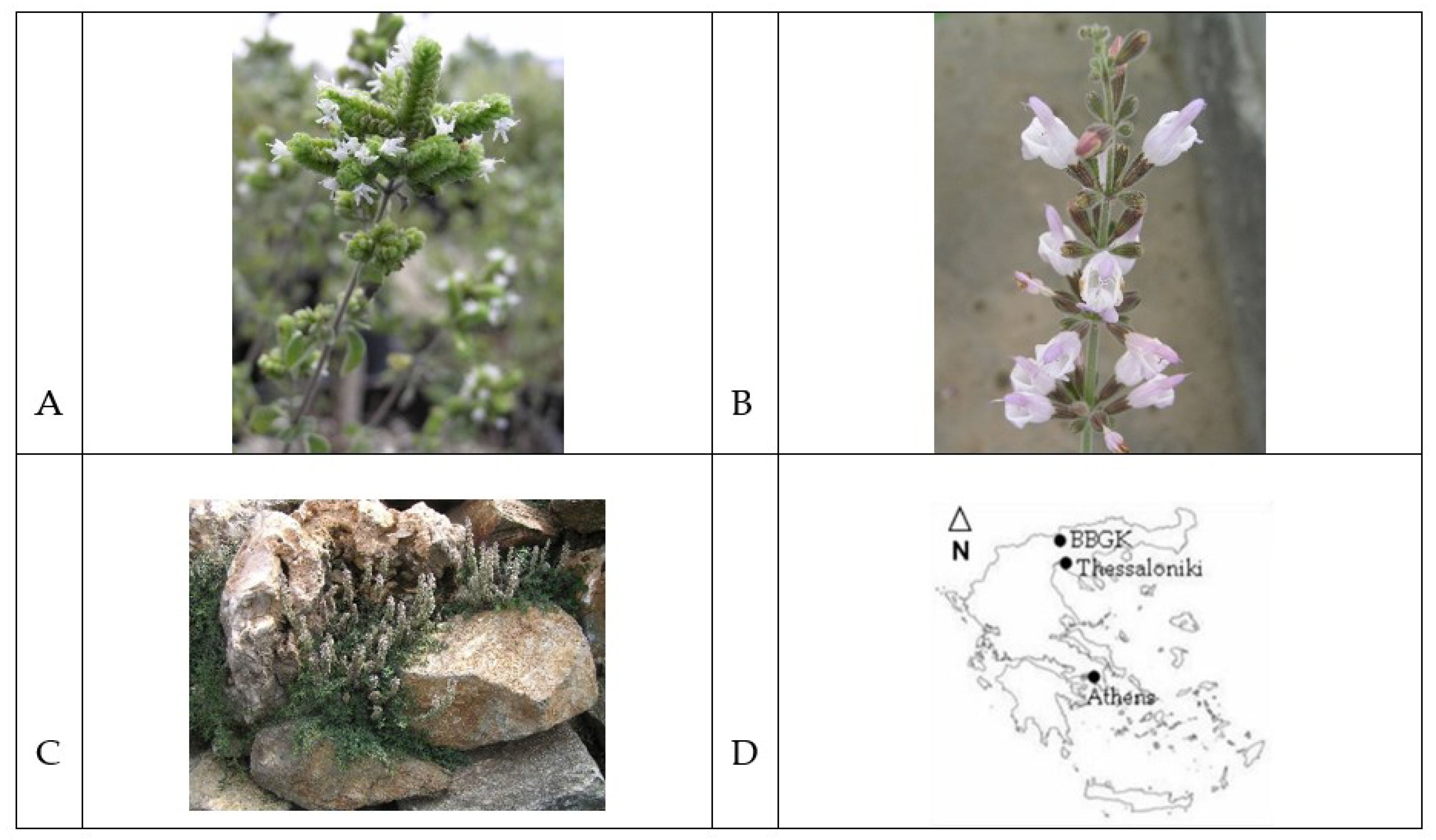


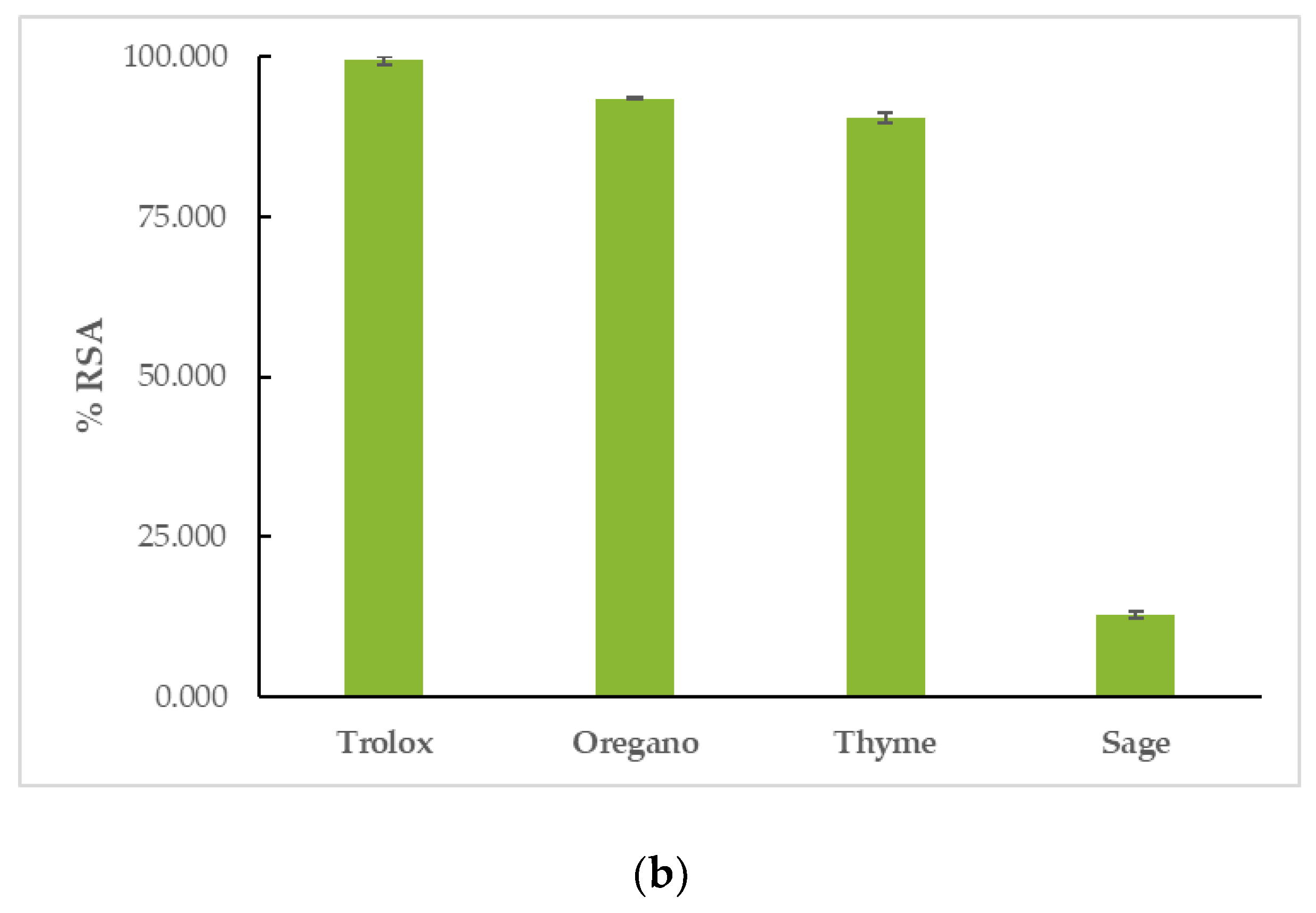
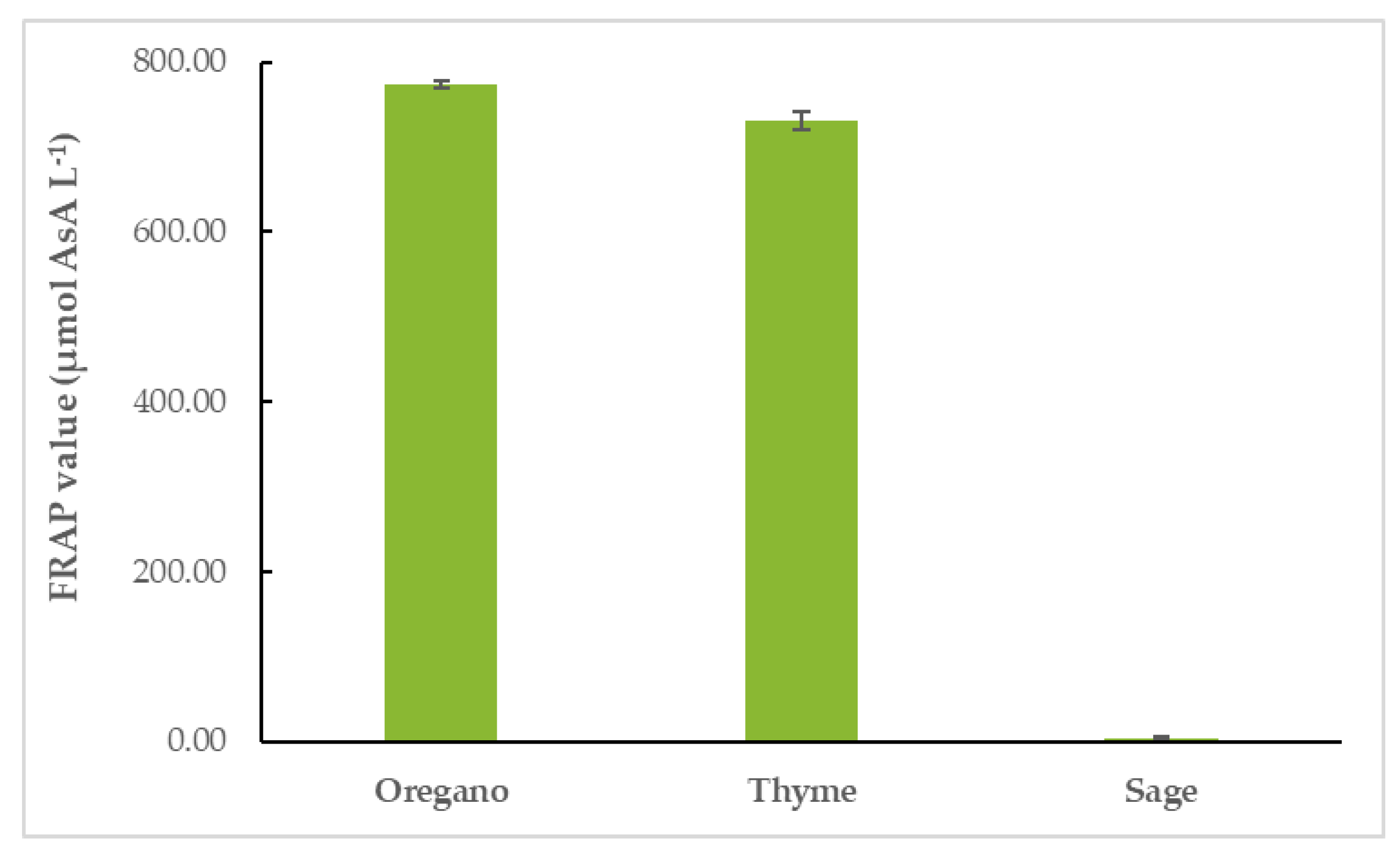
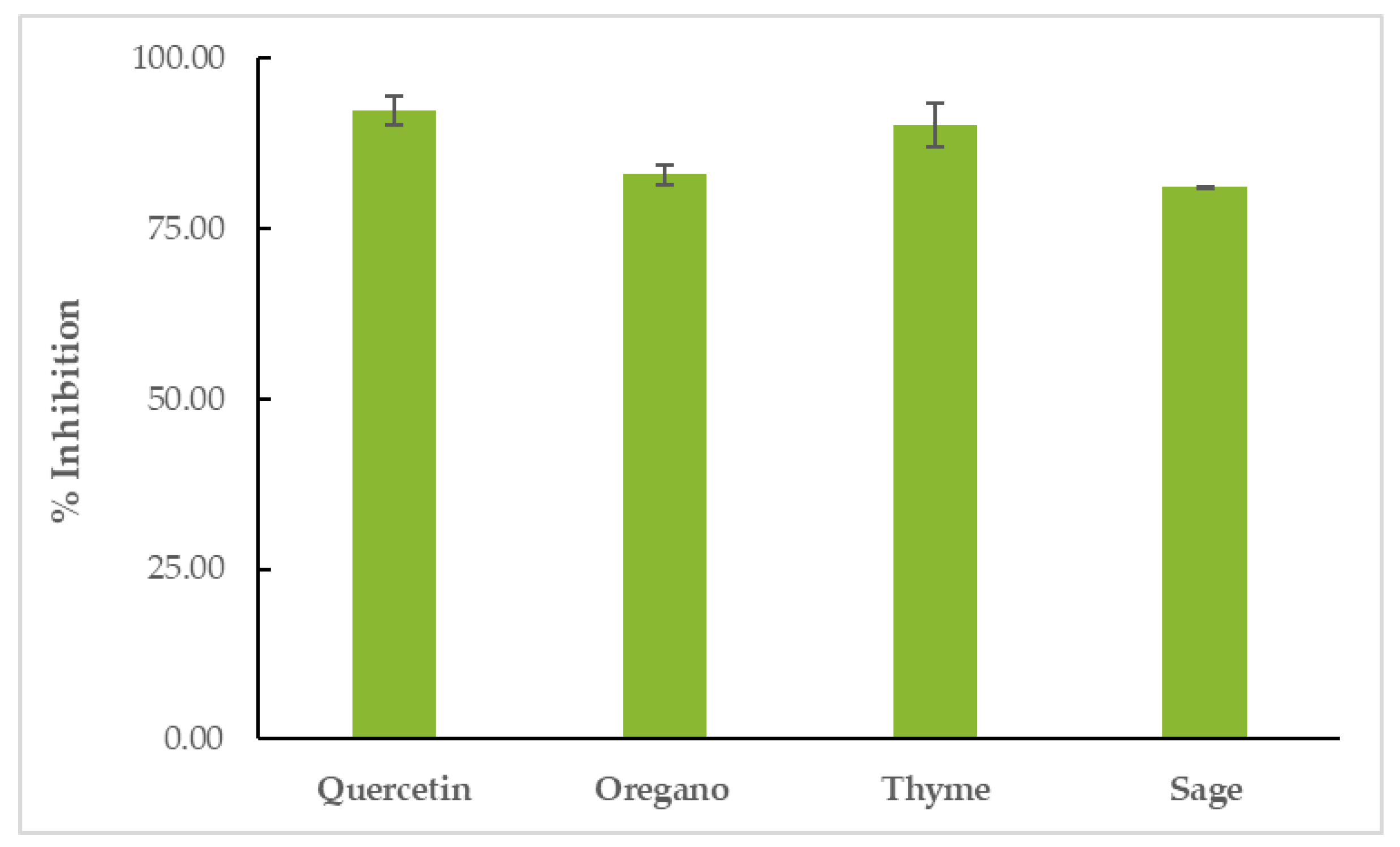
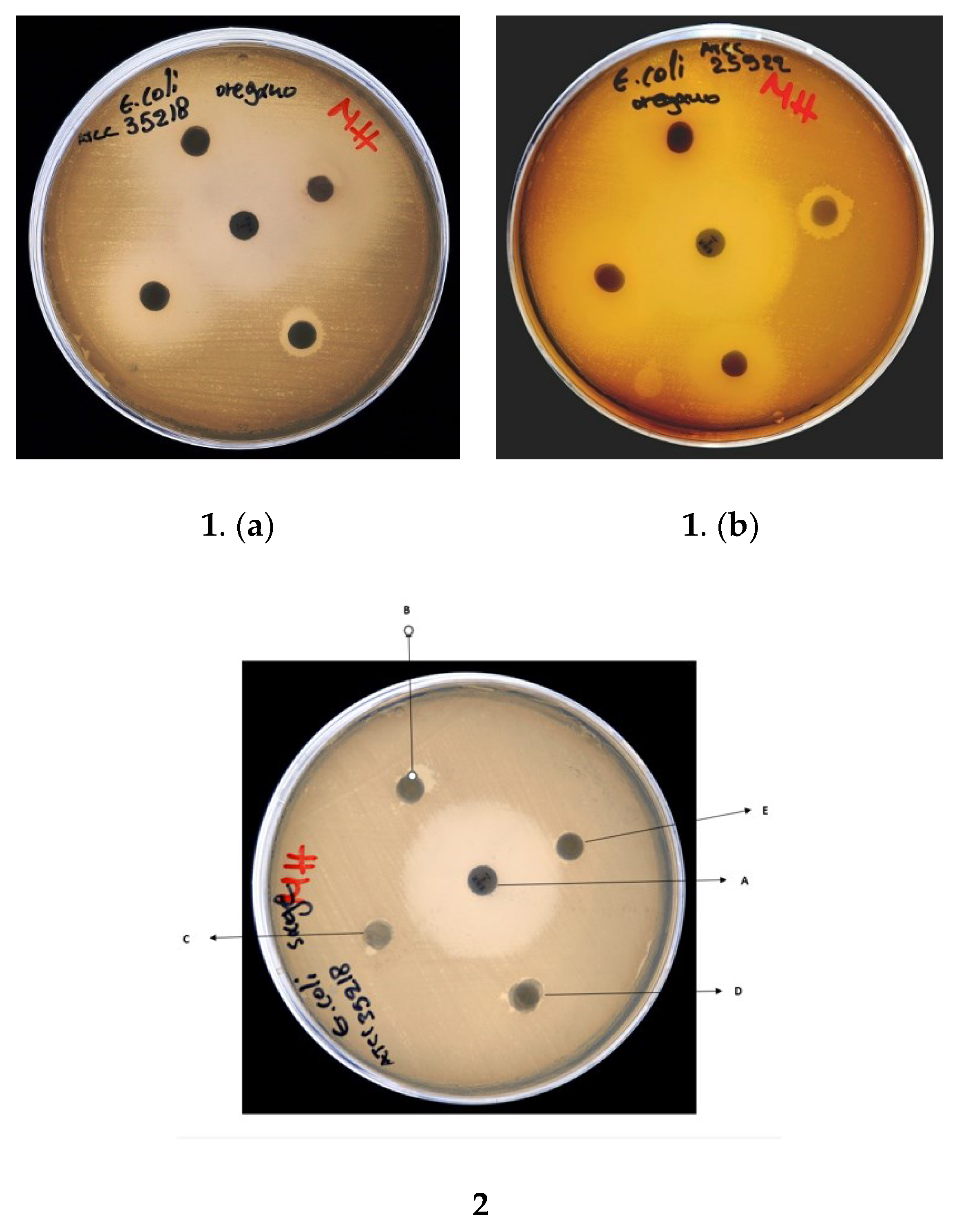


| Compounds 1 | Retention Time (min) | % | Identification Method 2 |
|---|---|---|---|
| α-Pinene | 4.399 | 0.52 | RT, MS, Co-GC |
| α-Thujene | 4.534 | 0.83 | RT, MS, Co-GC |
| Camphene | 5.510 | 0.07 | RT, MS |
| α-Phellandrene | 9.863 | 0.23 | RT, MS |
| β-Myrcene | 10.210 | 2.03 | RT, MS, Co-GC |
| α-Terpinene | 10.808 | 1.84 | RT, MS, Co-GC |
| γ-Terpinene | 16.641 | 10.59 | RT, MS, Co-GC |
| p-Cymene | 19.608 | 8.90 | RT, MS, Co-GC |
| 1-Octen-3-ol | 34.963 | 0.61 | RT, MS |
| cis-Sabinenehydrat | 35.365 | 0.34 | RT, MS |
| β-Caryophyllene | 40.800 | 1.01 | RT, MS, Co-GC |
| 1-Terpinen-4-ol | 41.688 | 0.37 | RT, MS, Co-GC |
| Thymol methyl ether | 41.829 | 0.21 | RT, MS |
| Borneol | 45.772 | 0.40 | RT, MS, Co-GC |
| β-Bisabolene | 46.715 | 0.41 | RT, MS, Co-GC |
| Thymol | 62.680 | 3.69 | RT, MS, Co-GC |
| Carvacrol | 63.512 | 67.95 | RT, MS, Co-GC |
| Total essential oil yield (mL OEO 100 g−1 dry herb) = 5.49 ± 0.07 | |||
| Compounds 1 | Retention Time (min) | % | Identification Method 2 |
|---|---|---|---|
| α-Pinene | 4.417 | 0.99 | RT, MS, Co-GC |
| Camphene | 5.354 | 0.21 | RT, MS, Co-GC |
| α-Phellandrene | 9.517 | 0.11 | RT, MS |
| Myrcene | 9.865 | 0.98 | RT, MS |
| α-Terpinene | 10.438 | 0.66 | RT, MS, Co-GC |
| Limonene | 11.737 | 0.08 | RT, MS, Co-GC |
| β-Phellandrene | 12.349 | 0.07 | RT, MS |
| γ-Terpinene | 15.989 | 2.03 | RT, MS, Co-GC |
| p-Cymene | 18.854 | 5.00 | RT, MS, Co-GC |
| 1-Octen-3-ol | 34.646 | 0.40 | RT, MS |
| Linalool | 39.496 | 1.42 | RT, MS, Co-GC |
| β-Caryophyllene | 40.440 | 2.27 | RT, MS, Co-GC |
| Terpinen-4-ol | 41.392 | 0.72 | RT, MS, Co-GC |
| Borneol | 45.460 | 1.81 | RT, MS, Co-GC |
| Caryophyllene oxide | 55.279 | 0.23 | RT, MS, Co-GC |
| Thymol | 62.350 | 0.98 | RT, MS, Co-GC |
| Guaiol | 62.769 | 0.49 | RT, MS |
| Carvacrol | 63.156 | 80.68 | RT, MS |
| Apiol | 67.128 | 0.62 | RT, MS |
| Total essential oil yield (mL TEO 100 g−1 dry herb) = 4.15 ± 0.15 | |||
| Compounds 1 | Retention Time (min) | % | Identification Method 2 |
|---|---|---|---|
| α-Pinene | 4.330 | 5.90 | RT, MS, Co-GC |
| Camphene | 5.405 | 3.97 | RT, MS, Co-GC |
| β-Pinene | 6.760 | 1.62 | RT, MS, Co-GC |
| β-Myrcene | 9.989 | 3.50 | RT, MS |
| α-Terpinene | 10.555 | 0.11 | RT, MS, Co-GC |
| D-Limonene | 11.901 | 1.71 | RT, MS, Co-GC |
| Eucalyptol | 12.721 | 55.84 | RT, MS, Co-GC |
| γ-Terpinene | 16.172 | 0.05 | RT, MS, Co-GC |
| 3-Octanone | 17.964 | 0.09 | RT, MS |
| p-Cymene | 19.084 | 1.53 | RT, MS, Co-GC |
| Octen-1-ol, acetate | 30.336 | 0.07 | RT, MS |
| cis-Thujone | 31.641 | 1.87 | RT, MS, Co-GC |
| trans-thujone | 32.852 | 0.76 | RT, MS, Co-GC |
| Isopropenyl toluene | 33.090 | 0.05 | RT, MS |
| cis-Linaloloxide | 33.691 | 0.02 | RT, MS |
| 1-Octen-3-ol | 34.753 | 0.31 | RT, MS |
| Camphor | 36.630 | 9.82 | RT, MS, Co-GC |
| Linalool | 39.602 | 0.59 | RT, MS, Co-GC |
| Linalool acetate | 39.743 | 0.16 | RT, MS, Co-GC |
| Bornyl acetate | 40.241 | 0.45 | RT, MS, Co-GC |
| β-Caryophyllene | 40.565 | 0.37 | RT, MS, Co-GC |
| Fenchol | 40.765 | 0.04 | RT, MS |
| Aromadendrene | 40.993 | 0.11 | RT, MS |
| Terpinen-4-ol | 41.502 | 0.54 | RT, MS |
| α-Caryophyllene | 43.727 | 0.08 | RT, MS, Co-GC |
| Myrcenol | 44.572 | 1.07 | RT, MS |
| α-Terpineol acetate | 45.331 | 0.95 | RT, MS |
| α-Terpineol | 45.604 | 4.61 | RT, MS, Co-GC |
| Myrtenol | 49.163 | 0.10 | RT, MS |
| Nerol | 51.464 | 0.03 | RT, MS |
| Caryophyllene oxide | 55.424 | 0.12 | RT, MS, Co-GC |
| Ledol | 58.990 | 0.65 | RT, MS |
| Carvacrol | 63.317 | 0.69 | RT, MS |
| Aromadendrene oxide | 65.522 | 0.08 | RT, MS |
| Epi-13-Manool | 75.594 | 0.15 | RT, MS |
| Total essential oil yield (mL SEO 100 g−1 dry herb) = 4.66 ± 0.24 | |||
| Bacterial ATCC Strain | EO Concentration | Essential Oils | ||
|---|---|---|---|---|
| OEO | TEO | SEO | ||
| Diameter of Inhibition Zone (mm) | ||||
| S. aureus ATCC 29213 | * C = 100% | 30 | 30 | 18 |
| C = 50% | 30 | 30 | 18 | |
| C = 20% | 22 | 26 | 18 | |
| C = 5% | 12 | 12 | 0 | |
| Control_1 | 30 | 30 | 30 | |
| E. coli ATCC 25922 | C = 100% | 25 | 28 | 10 |
| C = 50% | 25 | 22 | 8 | |
| C = 20% | 20 | 18 | 0 | |
| C = 5% | 12 | 12 | 0 | |
| Control_2 | 33 | 33 | 33 | |
| E. coli ATCC 35218 | C = 100% | 28 | 30 | 0 |
| C = 50% | 25 | 26 | 0 | |
| C = 20% | 25 | 20 | 0 | |
| C = 5% | 8 | 14 | 0 | |
| Control_2 | 30 | 30 | 30 | |
| Lactobacillus fermentum ATCC 9338 | C = 100% | 35 | 35 | 8 |
| C = 50% | 35 | 35 | 8 | |
| C = 20% | 35 | 35 | 6 | |
| C = 5% | 35 | 35 | 0 | |
| Control_1 | 35 | 35 | 35 | |
| Bacterial Strains | Essential Oils | |||||
|---|---|---|---|---|---|---|
| OEO | TEO | SEO | ||||
| MIC (mg mL−1) | MBC (mg mL−1) | MIC (mg mL−1) | MBC (mg mL−1) | MIC (mg mL−1) | MBC (mg mL−1) | |
| S. aureus ATCC 29213 | 0.123 | 0.246 | 0.018 | 0.036 | 2.250 | 4.500 |
| E. coli ATCC 25922 | 0.031 | 0.031 | 0.036 | 0.071 | 2.812 | 0.563 |
| E. coli ATCC 35218 | 0.031 | 0.031 | 0.071 | 0.071 | 0.563 | 1.125 |
| L. fermentum ATCC 9338 | 0.031 | 0.031 | 0.071 | 0.071 | 2.250 | 2.250 |
| Time Point | Pretreatment | 100 μg mL−1 | 50 μg mL−1 | 20 μg mL−1 | 5 μg mL−1 |
|---|---|---|---|---|---|
| 2 hpi | OEO | 82.8 ± 6.95 | 15.5 ± 37.1 | 0 ± 0 | 0 ± 0 |
| TEO | 81.3 ± 14.1 | 62.8 ± 24.6 | 62.9 ± 20.3 | 24.1 ± 57.1 | |
| SEO | 72.2 ± 18.4 * | 33.0 ± 44.8 | 11.6 ± 35.0 | 5.25 ± 14.6 | |
| 24 hpi | OEO | 92.9 ± 6.9 | 81.5 ± 25.6 | 38.1 ± 13.1 | 33.3 ± 66.7 |
| TEO | 90.8 ± 17.9 | 73.1 ± 1.6 | 49.6 ± 54.9 | 67.4 ± 18.5 | |
| SEO | 89.6 ± 9.4 | 32.5 ± 65.1 | 31.6 ± 63.3 | 38.5 ± 42.5 |
Publisher’s Note: MDPI stays neutral with regard to jurisdictional claims in published maps and institutional affiliations. |
© 2022 by the authors. Licensee MDPI, Basel, Switzerland. This article is an open access article distributed under the terms and conditions of the Creative Commons Attribution (CC BY) license (https://creativecommons.org/licenses/by/4.0/).
Share and Cite
Sidiropoulou, E.; Marugán-Hernández, V.; Skoufos, I.; Giannenas, I.; Bonos, E.; Aguiar-Martins, K.; Lazari, D.; Papagrigoriou, T.; Fotou, K.; Grigoriadou, K.; et al. In Vitro Antioxidant, Antimicrobial, Anticoccidial, and Anti-Inflammatory Study of Essential Oils of Oregano, Thyme, and Sage from Epirus, Greece. Life 2022, 12, 1783. https://doi.org/10.3390/life12111783
Sidiropoulou E, Marugán-Hernández V, Skoufos I, Giannenas I, Bonos E, Aguiar-Martins K, Lazari D, Papagrigoriou T, Fotou K, Grigoriadou K, et al. In Vitro Antioxidant, Antimicrobial, Anticoccidial, and Anti-Inflammatory Study of Essential Oils of Oregano, Thyme, and Sage from Epirus, Greece. Life. 2022; 12(11):1783. https://doi.org/10.3390/life12111783
Chicago/Turabian StyleSidiropoulou, Erasmia, Virginia Marugán-Hernández, Ioannis Skoufos, Ilias Giannenas, Eleftherios Bonos, Kensilandia Aguiar-Martins, Diamanto Lazari, Theodora Papagrigoriou, Konstantina Fotou, Katerina Grigoriadou, and et al. 2022. "In Vitro Antioxidant, Antimicrobial, Anticoccidial, and Anti-Inflammatory Study of Essential Oils of Oregano, Thyme, and Sage from Epirus, Greece" Life 12, no. 11: 1783. https://doi.org/10.3390/life12111783
APA StyleSidiropoulou, E., Marugán-Hernández, V., Skoufos, I., Giannenas, I., Bonos, E., Aguiar-Martins, K., Lazari, D., Papagrigoriou, T., Fotou, K., Grigoriadou, K., Blake, D. P., & Tzora, A. (2022). In Vitro Antioxidant, Antimicrobial, Anticoccidial, and Anti-Inflammatory Study of Essential Oils of Oregano, Thyme, and Sage from Epirus, Greece. Life, 12(11), 1783. https://doi.org/10.3390/life12111783










